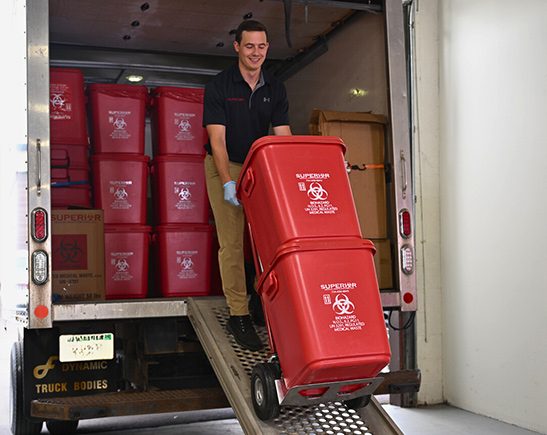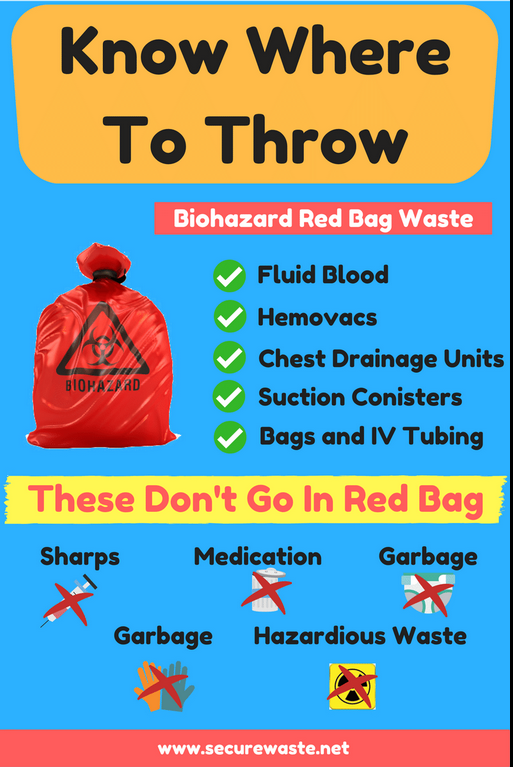Past Cleanup: Ensuring Safety And Security with Expert Medical Waste Removal
Wiki Article
Minimize Prices and Maximize Security: Effective Medical Garbage Disposal Techniques
Reliable clinical waste disposal methods are essential for healthcare facilities to decrease costs and optimize safety and security. By carrying out correct partition and classification, effective packaging and labeling, secure transportation and handling, effective treatment and disposal approaches, and compliance with regulative guidelines, healthcare centers can make sure the secure and responsible administration of clinical waste.
Correct Partition and Categorization
Appropriate segregation and categorization are crucial components of effective clinical waste disposal techniques, ensuring the security of health care workers, the public, and the environment - medical waste removal. medical waste disposal services with WasteX. By dividing various kinds of medical waste at the point of generation, health care centers can lessen the threat of cross-contamination and potential damage to ecological communities and peopleOne of the crucial aspects in proper partition is the identification and category of clinical waste. This includes classifying waste right into different teams, such as infectious, hazardous, radioactive, or pharmaceutical waste. Each category calls for details handling, storage, and disposal methods to avoid any kind of unfavorable results on human health and wellness and the setting.
Furthermore, appropriate segregation also includes making use of color-coded labels and containers to clearly recognize and set apart the various types of medical waste. This aids healthcare workers and waste management personnel to quickly identify and deal with the waste appropriately. For instance, red containers might be made use of for transmittable waste, while yellow containers might be assigned for hazardous waste.
In addition to partition, appropriate categorization likewise entails the proper packaging and control of medical waste. This ensures that waste is firmly stored and moved without positioning any type of threats to people or the setting. Using watertight and puncture-resistant containers, along with appropriately securing and identifying them, aids to stop any type of accidental direct exposure or release of hazardous materials.
Effective Packaging and Labeling
Efficient packaging and labeling play a vital duty in guaranteeing the reliable and secure disposal of medical waste. Appropriate packaging is important to prevent leak, breakage, or spillage throughout transport and handling. It aids to reduce the danger of contamination and shields medical care employees, waste management employees, and the atmosphere from potential hazards.Medical waste should be packaged in leak-proof and tough containers that are resistant to penetrate and damage. These containers ought to be appropriately sealed to stop any leakage. Furthermore, the packaging ought to be able to hold up against the conditions of transport, including temperature level variants and harsh handling.
Classifying is equally vital as it supplies vital details concerning the components of the waste and any type of potential hazards associated with it. The labels must include the name of the healthcare facility, the type of waste, and any kind of special handling instructions. Standard and clear labeling guarantees that waste monitoring workers can quickly recognize and take care of the waste appropriately.
Efficient packaging and labeling also help in the correct segregation and classification of clinical waste. Clear labeling permits for easy recognition of various waste streams, such as transmittable waste, sharps, or pharmaceutical waste. This assists in streamlining the disposal procedure and guaranteeing that the waste is treated or disposed of in conformity with regulative guidelines.
Safe Transportation and Handling
Ensuring the risk-free transport and handling of medical waste is of utmost relevance in order to prevent any kind of possible health and ecological threats. Medical waste, such as sharps, polluted products, and pharmaceutical waste, have to be effectively packaged and managed to decrease the threat of direct exposure to dangerous substances and pathogens.Moving clinical waste requires conformity with stringent regulations and guidelines set by regional authorities and ecological firms. These policies intend to secure the health and wellness of workers associated with waste administration and stop the launch of hazardous materials into the atmosphere.
To make certain risk-free transportation, medical waste must be put in puncture-resistant and leak-proof containers that are correctly secured and identified. In addition, it is critical to utilize customized vehicles outfitted with appropriate safety functions to carry medical waste. medical waste disposal services with WasteX.
Managing medical waste additionally needs proper training and adherence to security protocols. Personnel included in the handling of clinical waste must wear ideal individual safety equipment (PPE) such as gowns, masks, and handwear covers to lessen the threat of direct exposure. They ought to additionally comply with rigorous health methods to stop the spread of infections and make certain the secure disposal of waste.
Reliable Treatment and Disposal Techniques
Applying appropriate therapy and disposal methods is essential in handling clinical waste properly and decreasing prospective wellness and ecological dangers. Clinical waste, which consists Our site of sharps, infectious products, chemicals, and pharmaceuticals, can posture considerable risks if not managed and dealt with correctly. There are a number of therapy and disposal techniques readily available that follow regulatory guidelines and promote risk-free practices.One common technique is incineration, which entails melting the waste at high temperature levels. Incineration works in damaging pathogens and reducing the volume of waste, however it can launch harmful contaminants right into the air if not appropriately regulated. It is important to use modern-day incinerators geared up with emission control technologies.
One more approach is autoclaving, which makes use of steam and pressure to decontaminate the waste. Autoclaving is reliable in killing microorganisms and lowering the volume of waste, however it calls for mindful surveillance and maintenance to ensure proper functioning. The sterilized waste can after that be securely taken care of in a land fill.
Chemical treatment is an additional alternative, which includes utilizing disinfectants or various other chemicals to counteract microorganisms. This method is typically used for fluid waste, such as research laboratory samplings. It is vital to use suitable chemicals and adhere to appropriate procedures to make certain efficient treatment and prevent ecological contamination.

Conformity With Regulatory Guidelines
Complying with regulatory guidelines is important in making sure proper compliance with medical garbage disposal methods. These guidelines are implemented to secure public health, stop environmental contamination, and keep workplace safety and security. Conformity with regulatory guidelines is critical for health care facilities, as non-compliance can lead to penalties, penalties, and reputational damage.Regulatory guidelines describe the proper handling, storage, transport, and disposal of clinical waste. They give details directions on product packaging demands, labeling, and record-keeping. medical waste disposal services with WasteX These standards likewise next page deal with the segregation of different waste streams, such as sharps, transmittable waste, and pharmaceutical waste. Medical care centers should ensure that their waste monitoring practices line up with these guidelines to lessen the risk of direct exposure to hazardous products and avoid the spread of infections.
To keep compliance, medical care centers need to develop detailed waste monitoring programs that consist of team training, routine audits, and continuous tracking. It is necessary to keep up-to-date with any kind of updates or changes to regulative standards, as methods might progress gradually. By remaining educated and executing appropriate protocols, health care facilities can reduce the potential for regulative violations and protect the wellness and safety of their team, patients, and the surrounding community.
Conclusion
Finally, implementing efficient clinical waste disposal strategies is critical for lessening prices and optimizing security. Correct segregation and classification, effective product packaging and labeling, risk-free transport and handling, and efficient treatment and disposal approaches are necessary actions to make certain conformity with regulative standards. medical waste removal services. By adhering to these approaches, healthcare facilities can protect the environment and public health while likewise minimizing financial concerns connected with medical waste administrationBy applying proper partition and categorization, efficient product packaging and labeling, risk-free transport and handling, effective therapy and disposal approaches, and compliance with governing standards, health care centers can guarantee the liable and risk-free management of medical waste. Red containers might be utilized for contagious waste, while yellow containers might be assigned for harmful waste.
Clear and standard labeling makes certain that waste administration workers can easily recognize and take care of the waste suitably. (medical waste disposal services with WasteX)
Clear labeling allows for very easy identification of different waste streams, such as infectious waste, sharps, or pharmaceutical waste. These guidelines likewise resolve the segregation of various waste streams, such as sharps, infectious waste, and pharmaceutical waste.
Report this wiki page